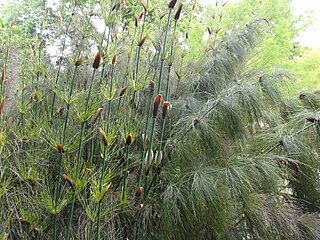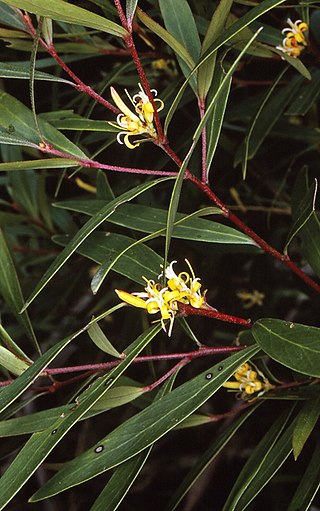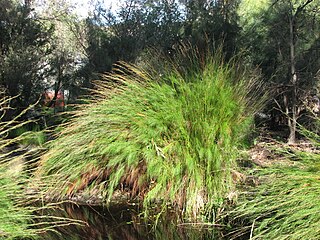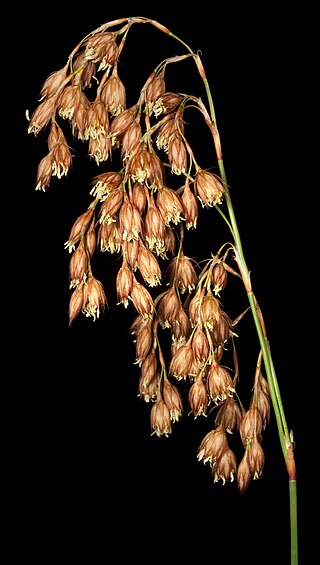
The Restionaceae, also called restiads and restios, are a family of flowering plants native to the Southern Hemisphere; they vary from a few centimeters to 3 meters in height. Following the APG IV (2016): the family now includes the former families Anarthriaceae, Centrolepidaceae and Lyginiaceae, and as such includes 51 genera with 572 known species. Based on evidence from fossil pollen, the Restionaceae likely originated more than 65 million years ago during the Late Cretaceous period, when the southern continents were still part of Gondwana.

Floydia is a monotypic genus of plants in the macadamia family Proteaceae which is endemic to Australia. The sole described species is Floydia praealta, commonly known as the ball nut. It is a somewhat rare tree found only growing in the rainforests of southeastern Queensland and northeastern New South Wales. The tree has a superficial resemblance to the closely related Macadamia and could be confused with them. The fruit of F. praealta is poisonous.
Hypolaena is a plant genus in the family Restionaceae, described as a genus in 1810. The entire genus is endemic to Australia.

Alexgeorgea is a genus of three plant species found in Western Australia belonging to the family Restionaceae named in honour of the botanist Alex George in 1976. The flowers of the female and large nut-like fruit are completely underground except for the stigmas, which extend out of the ground as 3 purple or red threads.

Persoonia silvatica, commonly known as the forest geebung, is a plant in the family Proteaceae and is endemic to south-eastern Australia. It is a shrub or tree with more or less lance-shaped leaves and small groups of yellow flowers with white centres. It grows mainly in forest near the border between New South Wales and Victoria.

Baloskion is a genus of rush-like plants from Australia.

Persoonia asperula, commonly known as mountain geebung, is a plant in the family Proteaceae and is endemic to south-eastern Australia. It is an erect or prostrate shrub with smooth bark, mostly elliptic to oblong leaves and yellow flowers borne singly or in groups of up to nine. It mostly occurs in the Southern Highlands of New South Wales. A small population in Victoria may be a different species.

Baloskion tetraphyllum is a rush-like plant in the family Restionaceae. Common names include tassel rope-rush, plume rush and Australian reed.

Persoonia isophylla is a plant in the family Proteaceae and is endemic to New South Wales. It is an erect or spreading shrub with soft, pine-like leaves and groups of cylindrical yellow flowers. It is similar to P. pinifolia but the flowers of that species have small leaves at their base, where the flowers of P. isophylla have full-sized leaves at their base. The two species sometimes grow together but hybrids between them are rare.

Persoonia acuminata is a plant in the family Proteaceae and is endemic to New South Wales. It is a spreading or prostrate shrub with relatively small leaves and cylindrical yellow flowers arranged singly or in groups of up to sixteen in leaf axils or on the ends of the branches. It grows in moist forest on the higher parts of the tablelands.

Persoonia rufa is a species of flowering plant in the family Proteaceae and is endemic to the a restricted area of New South Wales. It is an erect to spreading shrub with hairy young branchlets, elliptic leaves, and yellow flowers borne in groups of up to twelve on a rachis up to 110 mm (4.3 in), each flower with a leaf at its base.
Persoonia volcanica is a species of flowering plant in the family Proteaceae and is endemic to eastern Australia. It is an erect shrub with hairy young branchlets, egg-shaped to oblong leaves, and yellow flowers borne in groups of up to twenty on a rachis up to 180 mm (7.1 in) that usually continues to grow after flowering, each flower with a leaf at its base.

Desmocladus flexuosus is a rhizatomous, sedge-like herb in the Restionaceae family, endemic to south-west Western Australia.

Chordifex hookeri is commonly known as woolly buttonrush or cord-rush. It is a rush species of the genus Chordifex in the family Restionaceae. The species is endemic to Tasmania.

Chordifex laxus is a rush species of the genus Chordifex in the family Restionaceae. It is endemic to the south-west of Western Australia.

Chordifex microdon is a rush species of the genus Chordifex in the family Restionaceae, native to Western Australia.
Leptocarpus laxus is a rush species of the genus Leptocarpus in the family Restionaceae. It is endemic to the south-west of Western Australia.

Sporadanthus rivularis is a sedge-like herb in the Restionaceae family, native to Western Australia. It is a spreading perennial growing from rhizomes to heights of from 1 to 1.2 m, on black sands and clay along creek edges. It is a dioecious species.

Tremulina is a genus of flowering plants belonging to the family Restionaceae. The genus was first described in 1998 by Barbara Briggs & Lawrie Johnson. The type species is Tremulina tremula.

Tremulina tremula is a plant in the Restionaceae family, found in the south-west of Western Australia.















